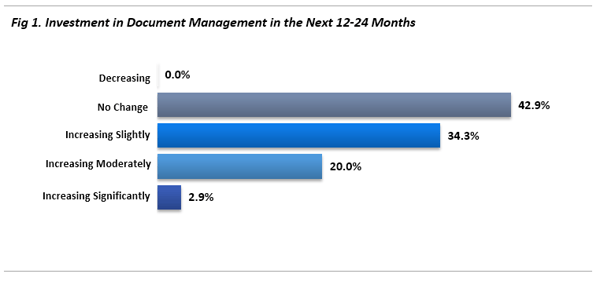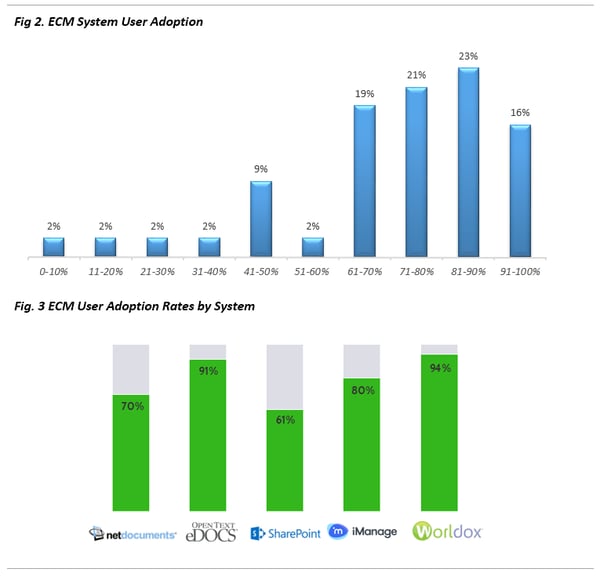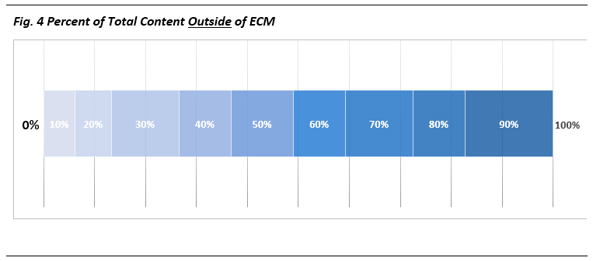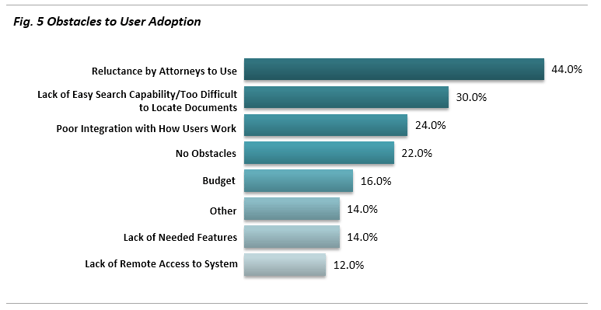
The Challenges of ECM Adoption
Ease of use and the “user experience” are among the most important and impactful topics for both solution providers and end users in ECM. The prevailing thought is that a user experience that is more seamless and less disruptive to human work processes (i.e. they eliminate or maintain process steps, not add new ones) will lead to higher rates of adoption by users and inclusion of content.
As a result, ECM solution providers have begun to develop ways to make points of entry more intuitive, to reduce the number of required clicks, to help users locate and access documents more easily and to offer other enhancements to user interaction, including passive processes that work in the background.
The promise of content management systems to capture and organize work product continues to be an attractive prospect to legal organizations, as shown by their growing footprint. Most legal organizations, both law firms and law departments, now have system-based ECM in place. Additionally, a majority of those organizations plan to increase their investment in content management in the short- to mid-term (Fig.1).

Access vs. Use
Perceptions about the adoption of ECM technologies vary widely, though our continuing research finds the trend for user-based reporting to be both very high and very optimistic. Our research also demonstrates clear adoption challenges to ECM, and so a dissonance emerges when comparing sentiments against achieved functional competencies. ECM systems command significant investment, in terms of both initial and ongoing capital and resource outlays, and the adoption of ECM technology often requires the widespread embrace of new institutional use paradigms; perhaps user adoption, then, is observed with “rose-colored lenses” of sort.
Despite continuing growth in ECM investment, the adoption of these systems by attorneys, paralegals and other users still lags. As reported by users, the average adoption rate of legal organizations is nearly 70 percent, and nearly 16 percent of ECM-enabled legal organizations reported universal adoption in our 2015 research (Fig. 2). System-specific adoption rates also paint an interesting and compelling picture of market dynamics (Fig. 3), and we review many factors and causalities that affect these in our MarketViewTM vendor evaluation reports.

On the whole, there is compelling reason to be skeptical about document management adoption figures.
When defined as actual content captured by and archived in enterprise document management systems, empirical data demonstrates a precipitous drop in adoption and confidence (Fig. 4). The high reported “adoption” figures in polling illustrate precisely the disconnect among users: the misconception that “adoption” relates to number of users with access to the system, regardless of how much they use it, is pervasive, and ignores – importantly – the amount of institutional content actually captured by the DMS.
Empirical research suggests that less than 46 percent of global active enterprise content is actually captured by the document management systems in place. Though adoption rates vary widely by organization, nearly two-thirds of organizations report actual content capture using DM, as a percentage of total content created and managed by the organization, at less than 50 percent. The single largest group reported total capture at 10 percent or less – or more than 90 percent of organizational content is not in the document management repository in place.

From the perspective of the user, we find that, interestingly, a lack of features or functionality is not raised as a major concern. Rather, the obstacles to adoption tend to focus on how ECM technologies support day-to-day work activities and enable users to work in more efficient, effective and collaborative ways.
We find two important factors that prevail in our research: 1) an ECM system configuration needs to relate closely to how users expect to accomplish their tasks; and 2) it must support users in the enviroments where they like to work. It comes hardly as a surprise, then, that the most common obstacles cited (Fig. 5) are the reluctance of attorneys to use the system (44 percent), difficulties in searching for and retrieving documents (30 percent), and poor integration with how users work (24 percent).

Ironically, the ease of use of local and shared drives, email, personal file sharing services, or even the old standard, redwell folders, enables the continued recalcitrance of attorneys to use content management systems. Unfortunately, this use paradigm is dangerous. As users create their own quasi-content environments – ad hoc and haphazard – they expose their organizations to a higher degree of professional and legal risk. Hence, risk mitigation and the need for centralized, secure content repositories continue to serve as primary drivers for more sophisticated and transparent system use models. In the language of one expert we engaged, the cure for “ECM avoidance” is to create “easy ECM” that requires little-to-no training, piggy-backs the ECM experience on the systems users already know and use and can draw user adoption with a lower expenditure of institutional energy.
It follows that a major focus of an ECM needs assessment must be a close study of the ways in which users work and the core values they prioritize. For example, the “appification” of productivity applications on smartphones and tablets has fundamentally changed the way knowledge workers create and interact with information, both in the current generation of workers as well as the generation of Millennials rapidly entering the workplace. It stands to reason that the same user experience will drive expectations for how desktop applications should function. The way we overlay ECM technologies to content creation applications will be critical for addressing not only compliance and governance requirements but as also the key determinates for efficient, effective and collaborative work processes.
Additional Information
For additional information about this Insight or Hyperion Research and our Market Intelligence Programs, please complete the short form below:


